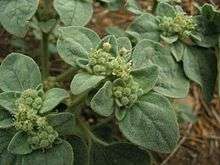Croton setigerus
| Croton setigerus | |
|---|---|
 | |
| Scientific classification | |
| Kingdom: | Plantae |
| (unranked): | Angiosperms |
| (unranked): | Eudicots |
| (unranked): | Rosids |
| Order: | Malpighiales |
| Family: | Euphorbiaceae |
| Genus: | Croton |
| Species: | C. setigerus |
| Binomial name | |
| Croton setigerus Hook. | |
| Synonyms | |
|
Eremocarpus setigerus | |
Croton setigerus (formerly Eremocarpus setigerus) is a species of plant known by the common names doveweed and turkey mullein. It is native to western North America, such as Montana and California. It has naturalized elsewhere, including parts of Australia.
This is a squat plant with furry, feltlike, hexagon shaped leaves, pale pink green in color. The small green flowers are covered in soft bristles.
Cultivation
Croton setigerus is used as an ornamental plant, its low and rounded form fills a pot.
The foliage is toxic to animals, and the crushed plants were used by Native Americans to stupefy fish and make them easy to catch. Turkey mullein was smoked to cure sore throats and cough. It can replace a fraction of tobacco.
The seeds are very palatable to birds, however; the common names of the plant come from the affinity of doves and wild turkeys for the seeds.
External links
- USDA Plants Profile: Croton setigerus (dove weed)
- CalFlora Database — Croton setigerus (dove weed
- CalFlora Database — Eremocarpus setigerus (dove weed, turkey mullein) — former name.
- Jepson Manual Treatment: Croton setigerus)
- Univ/ of Michigan: Dearborn — Ethnobotany
- C. setigerus in Australia